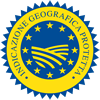Description
Limone Costa d’Amalfi PGI is a fresh citrus fruit belonging to the Citrus limon L. species, deriving from the Sfusato Amalfi tano cultivar.
Production Area
The production area of Limone Costa d’Amalfi PGI is within the entire territory of the Municipality of Atrani and in part of the municipalities of Amalfi, Cetara, Conca dei Marini, Furore, Maiori, Minori, Positano, Praiano, Ravello, Scala, Tramonti and Vietri sul Mare, in the Province of Salerno, in the Campania region.
Production Method
Limone Costa d’Amalfi PGI is obtained from a form of terrace cultivation that renders sloping terrain cultivable. The units are bordered by walls, locally known as macere. This production method requires a lot of maintenance in order to ensure the correct drainage of the water (through the elimination of weeds from the walls). The trees are grown under typical wooden frames, with a height of no less than 180 cm, at times with covering to protect the trees from adverse weather conditions that could delay ripening. No pruning is carried out during the first two years, but the branches of the plant are tied to the stakes and left to grow freely. Harvesting is carried out exclusively by hand, taking care to not let the fruit touch the ground; it generally takes place between February and October, although there can be variations due to weather conditions.
Appearance and Flavour
Limone Costa d’Amalfi PGI is elliptic in shape, with a light yet intense yellow skin of average thickness. It is characterised by an intense aromatic smell due to the presence of essential oils, and is separated from the flesh by a white sponge-like layer. It has seedless, abundant straw-yellow-coloured flesh, with highly acidic juice and a very strong aroma.
History
The highly praised qualities of Limone Costa d’Amalfi PGI have been enjoyed for many centuries. A few paintings in the Orchard House in Pompeii, dating back to the beginning of the 9th century, portray the typical colours of the Amalfi Coast. During this period, the landscape was dotted with lemon-groves, re-named “gardens” because of their beauty and the special care given to them, which were extremely useful for safeguarding the area from hydrological instability. Lemon growing also gave the inhabitants of Amalfi, a seafaring population, access to an effective cure against scurvy whilst at sea. From the 15th century onwards, there was a flourishing maritime trade in these citrus fruits, leaving from the town of Minori and arriving in numerous other European and Italian ports, at the same time encouraging the widespread creation of lemon gardens.
Gastronomy
Limone Costa d’Amalfi PGI can be kept either in the fridge or in a cool, dry place. It can be eaten fresh or used as a basic ingredient in many different dishes. As it is very versatile, there is no dish that doesn’t benefit from its juice, flesh or grated rind. It is traditionally consumed fresh, cut into slices, with a pinch of salt or sugar, mint leaves and vinegar. However, it is also perfect for using in starters, fish or meat dishes, as well as combined with vegetables and fruit. Limone Costa d’Amalfi PGI makes an ideal base for jams, marmalades and preserves, and can also be used in biscuits, desserts, and liqueurs like Liquore di Limone della Costa d'Amalfi PGI.
Marketing
The product is marketed as Limone Costa d’Amalfi PGI. It is sold fresh from February to October, with a unit weight of 100 g per lemon, or in rigid containers weighing from 0.5 kg to 15 kg. It is also available as a transformed product, such as Limoncello made from Limone Costa d’Amalfi PGI.
Distinctive Features
Recent chemical-food studies have established that Limone Costa d’Amalfi PGI contains almost double the quantity of aromatic hydrocarbon in respect to other lemons.


































